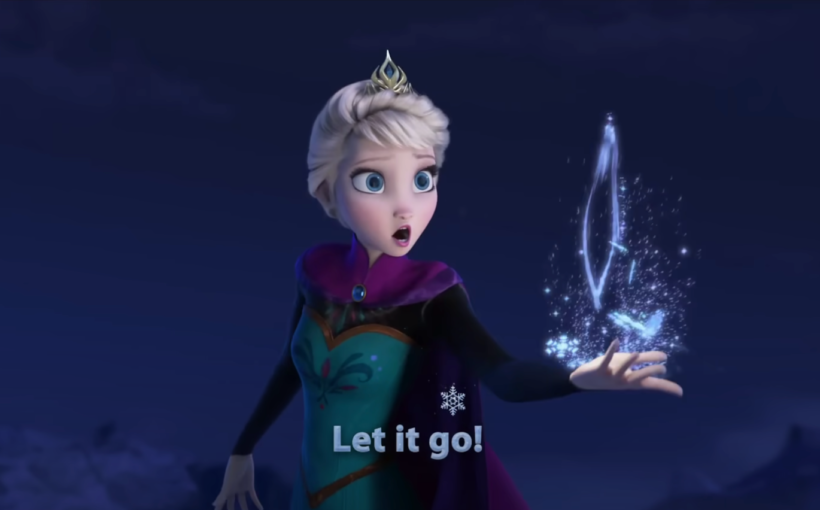
Ten years ago a musical phenomenon hit our screens, one which captured the hearts of a large and diverse audience and whose songs have already become classics. The 2013 film Frozen is now widely recognised as one of the most memorable and loved Disney animated films, whether measured economically or by popular critical reception.
Frozen’s revision of the Disney Princess genre clearly resonated with audiences of all ages. Its message of empowerment and self-determination spoke to present day concerns about gender, sexuality and identity. Music was central to communicating these ideas, especially the showstopping song Let It Go.
A large part of that musical appeal has been singalongs, inviting audiences to go beyond watching and listening to interactively participating. The popularity of Frozen singalongs might be assumed to be a new phenomenon in cinema spectatorship and consumption. However, they continue a century-long tradition of cinema singing that has been forgotten.
Singalongs in cinema history
In the 1910s and 1920s, community singing movements became a popular shared musical activity in Britain, Australia, the US and beyond.
Community singing was seen to foster musical appreciation, patriotic ideals and individual mental health. It often took place in cinemas. While songbooks or illustrated song slides were commonly used, many singalong films were also made, providing onscreen lyrics to support the collective singing.
The Fleischer animation studio innovated the “bouncing ball” lyric presentation in its Song Cartune singalong cartoon series between 1924 and 1927. It continued as the Screen Songs series until the 1950s.
In the 1930s, Mickey Mouse clubs and other children’s cinema screenings routinely included communal singing to bond the audience with each other and fostering brand loyalty.
The rise of radio and television broadcasting in the mid-20th century meant singalongs migrated to these new media. Now, the audience was increasingly expected to imagine their shared participation with a dispersed audience, mediated through these new technologies.
The 1930s Gillette and Palmolive Community Sing radio shows, broadcast by the American CBS network, indicate the way singalongs were increasingly used as a vehicle for sponsorship and advertising. Similarly, in Australia, the local Aeroplane Jelly brand used singalongs to promote their products in cinemas.
The British Ovaltine malted milk drink likewise used singalongs to connect with consumers, both in radio broadcasts on Radio Luxembourg and tie-in events with cinema clubs. Retro reuse of these examples in more recent years indicate how singalongs had become a nostalgic relic of the past.
Singing along with Frozen
Frozen has tapped into this history. In January 2014, two months after Frozen’s initial box office success, Disney re-released the film in a singalong version. This included on-screen lyrics and a bouncing snowflake to guide audiences – the bouncing ball of the Fleischer animation studio Frozen-ified.
This version was subsequently released as a special edition DVD in November 2014. Singing along was so popular that Disney released a singalong version of the soundtrack. The CD featured instrumental versions of the songs and came with a lyric book.
Typical of Disney’s cross-promotional synergy, the corporation’s theme parks started hosting singalong events in 2014. For the First Time in Forever: A Frozen Sing-Along Celebration opened at the Florida Walt Disney World resort in July 2014 and went on to feature at Disney parks around the world, including multiple localised language versions.
The Disney-sanctioned singalongs have stimulated widespread fan activity and social media singalongs. In 2015, a family screening of the singalong version of Frozen in London’s Hyde Park was awarded a Guinness World Record for the most people singing live in a radio broadcast.
Frozen songs have become a staple for school and community choirs, with countless examples uploaded to YouTube. During the COVID-19 pandemic, virtual choirs singing Frozen songs provided an opportunity for human contact during months of isolation and lockdown.
YouTube and TikTok are also filled with innumerable videos of fans singing along with Frozen songs. The Disney Junior UK TV channel ran a Facebook competition inviting viewers to submit their own rendition of Let It Go, and the compilation has been viewed more that 250 million times.
In the present day, with cinema attendance needing to compete with the convenience of streaming services, special events and interactive audience participation are becoming increasingly popular.
The renewed interest and popularity of singalongs, thanks in part to the success of Frozen, provides one way to attract audiences back. With two further Frozen sequels in the works, it seems like audiences will be singing along with Anna and Elsa for the next ten years.
![]()
Malcolm Cook does not work for, consult, own shares in or receive funding from any company or organisation that would benefit from this article, and has disclosed no relevant affiliations beyond their academic appointment.



